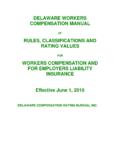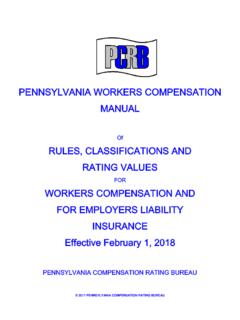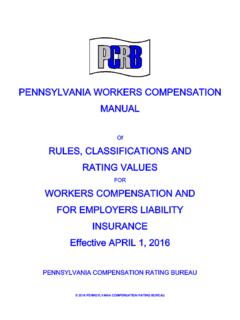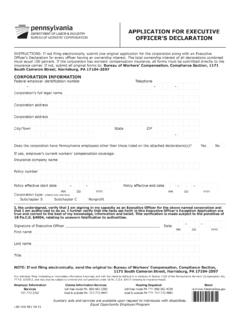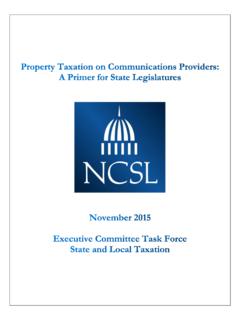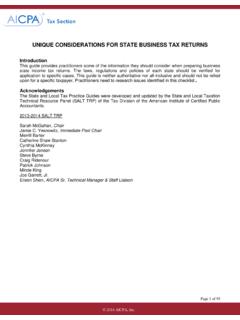Transcription of Pennsylvania Compensation Rating Bureau - DCRB
1 Pennsylvania Compensation Rating Bureau Comparison of Rates: Pennsylvania to Other Northeast States Pennsylvania Rating Values Effective April 1, 2010 This report updates similar analyses previously prepared by the Pennsylvania Compensation Rating Bureau (PCRB). For Pennsylvania in particular, this analysis includes recognition of the continuing impacts of Act 44 enacted in July 1993 and Act 57 enacted in June 1996. For all jurisdictions included in the comparison, classification changes and/or revisions to Rating values occurring through July 1, 2010 are reflected herein. Discussion of workers Compensation systems often includes claims or assertions regarding the relative premium costs for this line of insurance in various state jurisdictions. The PCRB is mindful that true premium costs for workers Compensation insurance in different states are the result of many variables not generally susceptible to simple or generalized analysis.
2 Especially important variables of this type include differences in classification plans approved in different states and competitive pricing differentials applied by insurance carriers in each jurisdiction. In the interest of informing various parties currently engaged in discussions concerning the Pennsylvania workers Compensation system regarding comparative system costs, the PCRB has compared approved rates in several selected northeastern states to those of Pennsylvania using an approach which recognizes both of these notable variables. The results of that comparison are presented and discussed in this report. OVERVIEW OF STUDY RESULTS Pennsylvania s lowest approved rates for the classifications studied tended to be lower than the lowest approved rates for New Jersey and Ohio (except manufacturing classes) and higher than the lowest approved rates of Delaware (except manufacturing classes), Maryland, New York (except contracting classes) and West Virginia.
3 Pennsylvania s highest approved rates for the classifications studied tended to be lower than the highest approved rates of Maryland, New York, New Jersey (except for manufacturing and contracting classifications) and higher than the highest approved rates for Delaware (except manufacturing classifications), Ohio (except other classifications) and West Virginia (except other classifications) . In addition to the Rating values shown in Exhibits 1 and 3, the final costs to policyholders may be significantly influenced by various assessments and/or surcharges that are applicable to premiums rather than rates. The following list shows additional costs that apply to premiums rather than rates for the states included in this study. Pennsylvania - Employer assessment factor Delaware None Maryland Premium Tax , Subsequent Injury Fund , Uninsured Employers Fund and Workers Compensation Commission Tax Pennsylvania Compensation Rating Bureau Comparison of Rates: Pennsylvania to Other Northeast States Rating Values Effective as of April 1, 2010 Page 2 New Jersey Plan Premium Adjustment Program (assigned risk) minimum surcharge 15%, Second Injury Fund and Uninsured Employers Fund New York Workers Comp Board , Reopened Case Fund , Specialty Disability Fund , Interdepartmental Expenses and Special Funds Conservation Committee Ohio None Note: For Ohio certain assessments and/or charges are included in the Rating values shown in Exhibits 1 and 3.
4 Specific charges and the manner of their application in Ohio is discussed later in this narrative. West Virginia Regulatory Surcharge , Premium Tax (waived while Deficit Reduction Surcharge is being charged), Premium Tax Surcharge and Deficit Reduction Surcharge This study was limited by design to a comparison of approved carrier rates in the selected jurisdictions. Such rates exclude potential effects of a broad variety of special Rating programs which may be available in some jurisdictions. Thus, this study is directed at the benchmark tabular rates used by insurers as a starting point in determining final premiums but has not analyzed the complex series of possible additional steps which may actually apply in determining each insured s policy premium. As examples of such additional factors, Pennsylvania employers may qualify for some or all of the following special pricing programs.
5 Safety Committee credits premised upon qualification of safety committee activities in the employer s business Construction Classification Premium Adjustment Program credits which recognize effects of significant differences in wage levels between employers on workers Compensation insurance premiums Group Insurance Programs which allow consolidation of experience for purposes of loss-sensitive pricing programs filed by individual insurers Subclassifications adopted by individual insurers subject to different Rating values than those produced by the combination of PCRB loss costs and the insurers loss cost multiplier(s) Retrospective Rating plans which effectively rely on the insured s own loss experience in determining final insurance prices Deductible coverages which allow employers to reduce their workers Compensation insurance premiums in return for accepting responsibility for initial payments on claims which may occur for their employees Pennsylvania Compensation Rating Bureau Comparison of Rates: Pennsylvania to Other Northeast States Rating Values Effective as of April 1, 2010 Page 3 Schedule Rating plan adjustments, including use of either a PCRB plan filed on behalf of all its members or of carrier-specific plans Each jurisdiction studied showed substantial ranges of approved rates within many given Pennsylvania classifications.
6 These ranges of approved rates are attributable in part to differences in carrier pricing initiatives and values, such as deviations or loss cost multipliers, and/or to differences in the structure of approved classifications which cause parts of multiple different classifications in some states to be equivalent to parts of a single common classification in Pennsylvania . Competitive differences in carrier pricing programs are applicable in deriving comparisons of Pennsylvania rates to those of Delaware, Maryland and New York, and, in fact, produce very significant ranges of carrier rates even within Pennsylvania itself for any given classification. Differences in classification plans apply in the comparisons with all states, although the State of Delaware uses a classification system which was identical to that of Pennsylvania for 29 of the 32 classifications included in this study.
7 While rate comparisons often include statements to the effect that state X rates are blank percent higher (or lower) than those of state Y, this study did not produce single factors for comparison of rates between states. Actually deriving such point estimates would require a significant amount of detail not generally available for analysis. To accurately establish rate differences in this fashion would require separate exposure data within a state consistent with the approved classification plan(s) of any other state(s) being included for comparison and separately reported for each carrier using different rate levels ( , rate deviations or loss cost multipliers). Without such detailed information, the proper weights cannot be determined for purposes of computing average rates in each state, and, without benefit of these appropriate weights, averages or other similar statistics taken from different states must be viewed with caution.
8 STRUCTURE OF THE STUDY Because the PCRB wanted to be able to comprehensively and correctly identify and account for differences in classification plans in this study, our analysis was limited to certain selected Pennsylvania classifications. In previous reports, the PCRB selected ten classifications from each of the three traditional industry groups commonly used in workers Compensation pricing analysis: Manufacturing, Contracting and Other Industries. These selected classifications were large classifications as measured by expected losses, a statistic derived by multiplying recent exposures (generally payrolls) times the currently-approved PCRB loss cost values by classification. By request received early on during its initial study, the PCRB included two additional classifications, Sawmills and Logging, bringing the total number of classifications studied to 32.
9 In preparing this updated comparison, the PCRB again reviewed the most current available data to determine the extent of any changes which may have occurred in the largest classifications within each industry group. The ten largest classifications in each industry group have again been selected, together with the Sawmill and Logging codes included in previous studies. Of the 30 large classifications used in the previous report, 28 remain among the largest ten classifications in their respective industry group. Pennsylvania Compensation Rating Bureau Comparison of Rates: Pennsylvania to Other Northeast States Rating Values Effective as of April 1, 2010 Page 4 In order to compare Pennsylvania rates to any other jurisdiction(s), a cross-reference between the classification plans used in Pennsylvania and the comparison state(s) was needed.
10 Development of such a cross-reference involved a thorough review of classification manuals in each other jurisdiction considered for comparison and required a significant effort by trained PCRB staff. Cross-references were developed for the following states: Delaware, Maryland, New Jersey, New York, Ohio and West Virginia, states having common borders with Pennsylvania . In Ohio there are four employer assessments which apply in addition to published Ohio rates. A summary of these assessments follows: Disabled Workers Relief Fund: A flat $ per $100 of payroll in addition to applicable premium rates for private employers, $ per $100 of payroll for public employer taxing districts and $ per $100 of payroll for public employer state agencies. Additional Disabled Workers Relief Fund: An additional percent of base-rated premium for private employers, public employer taxing districts and public employer state agencies.

